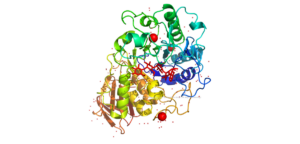Microbial enzymes are potential biocatalysts that are extensively used in various industries such as fermentation, food, agricultural, chemical and pharmaceutical. These enzymes derived from different microorganisms are used to produce 0ver 500 commercial products.
A substantial number of microbial enzymes have found their wide use across different industries throughout the world. Bacteria, fungi, and yeasts are the selected microorganisms that are globally studied for the biosynthesis of a wide range of microbial enzymes.
Microbial enzyme examples:
- α-amylase
- Glucoamylase
- Protease
- Lactase (β-galactosidase)
- Lipase
- Phospholipase
- Esterase
- Cellulase
- Xylanase
- Pectinase
- Glucose oxidase
- Laccase
- Catalase
- Peroxidase
- α-Acetolactate dehydrogenase
- Asparaginase
- Debittering enzymes – naringinase
In the following section, we will learn about the above-mentioned enzymes in detail.
α-amylase
α-amylase is specifically used for starch conversion. It is capable of hydrolyzing internal α-1,4-glycosidic linkages present in low molecular weight oligo- and polysaccharides. α-amylases are widely used in the brewing and baking industry.

It is also used as a digestive aid in the pharmaceutical industry.
Glucoamylase
Glucoamylases also known as saccharifying enzymes are used in the food industry for the production of high-glucose syrups. They also find their use in the baking industry for the production of high-quality baked products. This enzyme plays a key role in the production of soya sauce and the reduction of alcohol content in the beer.
Protease
Proteases hydrolyzing peptide bonds found in proteins are well-known biocatalysts in the dairy industry. They reduce allergenic traits of milk products, enhance cheese flavor and accelerate cheese ripening.
Lactase (β-galactosidase)
The use of lactase in milk-based products aids in reducing lactose intolerance in people. Hydrolysis of lactose with lactase significantly improves the creaminess of ice creams. Lactase also plays a crucial role in lowering lactose-related biological oxygen demand during cheese production.
Lipase
Lipases are commercially used in the dairy industry for enhancing cheese flavor. It is also used to modify the aroma of wine and to improve cocoa butter quality. Moreover, this enzyme is known to be widely used in the biofuel, detergent, and leather industries.
Phospholipase
Phospholipases are used for the production of oils by breaking down phospholipids into fatty acids. These enzymes are also used in the degumming of vegetable oils.
Esterase
Esterases play a significant role in the alcoholic beverage and food industries. Feruloyl esterase contributes to the fruity aroma in foods and beverages by the biosynthesis of ferulic acid.
Cellulase
Cellulases are popular biocatalysts used in the juice industry for increasing yield. These enzymes enhance the aroma and taste of citrus fruits by reducing their bitterness. Cellulases are used in wine production to improve quality and color.
Xylanase
Xylanases known to cleave xylans are extensively used in bread making as they increase bread volume and improve bread quality. Its use also improves the taste and texture of biscuits. These enzymes improve extraction in juice production thereby increasing juice yield.
Pectinase
Pectinases capable of hydrolyzing glycosidic bonds in pectic polymers are used in juice production. This enzyme removes the turbidity of naturally derived fruit juices and improves drink flavor and color of the drink.
Glucose oxidase
Glucose oxidase belongs to the oxidoreductase enzyme family. It is widely used in the baking, pharmaceutical, and food industry. The use of this enzyme prevents the rotting of food by improving the shelf life of food products. It is also used to remove oxygen in order to increase storage life.
Laccase
Laccases are used in beverage and food industries to modify color appearance. It finds its use to improve the storage life of beer by removing oxygen in the final step of beer production. Interestingly, laccases are used in the cork stopper manufacturing industry.
Catalase
Catalase finds its use in the fabric industry for the removal of excess hydrogen peroxide from fabric. It is used for food preservation and the elimination of peroxide from milk. Also, catalase prevents oxidation in food wrappers.
Peroxidase
Peroxidase is used for producing flavor in the food industry. It plays a key role in managing environmental pollution by treating industrial phenolic effluents. It is also used as a biosensor.
α-acetolactate dehydrogenase
α-acetolactate dehydrogenase speeds up beer maturation by removing α-acetolactate and α-Aceto-α-hydroxybutyrate. Surprisingly, beer maturation takes 2 to 12 weeks without this enzyme, whereas the use of α-acetolactate dehydrogenase results in maturation within 24 hours.
Asparaginase
Asparaginase is majorly used in the pharmaceutical industry as an anticancer agent. It catalyzes the breakdown of asparagine an essential amino acid for the growth of cancerous cells.
Debittering enzymes – naringinase
Naringinase breaks down naringin responsible for bitterness in citrus fruits. The use of naringinase helps in debittering fruit juices.
What are microbial enzymes?
Microbial enzymes discovered from microorganisms are used as organic catalysts for the large-scale manufacture of commercially used products. These enzymes possessing special characteristics such as the capability to function under abnormal conditions are designed using protein engineering, metagenomics, and biochemical reaction engineering.
Microbial enzyme structure
Like all other enzymes, the primary structure of microbial enzymes is made up of amino acids that are linked together by peptide bonds in a linear chain.
Also Read:
- Are bacteria diploid
- Aquatic biome examples
- Are algae eukaryotic
- Adenine vs cytosine
- Is cyanobacteria unicellular or multicellular
- Is dna replication semiconservative
- Exocytosis example
- Monogenea characteristics
- Spiral bacteria examples
- Endotoxin bacteria examples 2
Hi..I am Moumita Nath, I have completed my Master’s in Biotechnology. I always like to explore new areas in the field of Biotechnology.
Apart from this, I like to read, travel and listen to Music.